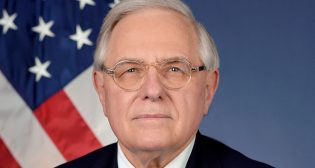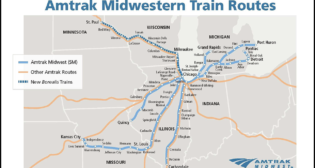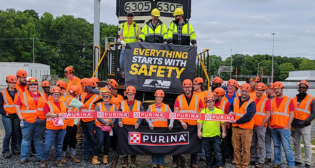
Dahlman Rose conference: Railroads focus on growth opportunities
Written by William C. Vantuono, Editor-in-ChiefDespite disturbing new signs of an economy that may be sliding back toward deep recession, the railroads continue to focus on emerging growth opportunities while staying the course on well-established traffic. At the fourth annual Dahlman Rose & Co. Global Transportation Conference, Class I representatives as well as officers from several major short line holding companies and a major trucking/intermodal company weighed in on topics ranging from capex to coal.

Surface Transportation Board Chairman Daniel R. Elliott III’s (top) keynote address focused on the regulatory agency’s changing nature. The railroad story since deregulation “has been an uneven story,” Elliot said, citing consolidation that has resulted in only seven large railroads and eastern and western duopolies,. “Many shippers say deregulation has worked all too well.” At present, the STB, faced with limited resources, is examining major changes to the way railroads are regulated. In question, said Elliott, is “whether changes in Board policy can help improve competition while making sure that railroads can continue to invest.”
The STB continues to examine such key issues as rail competition for captive shippers, commodities exemptions, and filing fees. “We will go wherever the analysis takes us, however long it takes,” Elliott said, offering no timeline for when and if any rules changes (with Congressional concurrence) would be implemented. In the midst of that, the Board “has been philosophically moving away from court model to a mediation model. We’ve been very successful in dispute resolution. My goal is that the STB be seen as an honest broker by railroads, shippers, and Congress,” he said.
Following are comments from some of the key presenters:.
CN Vice President Investor Relations Robert Noorigan: “Our business mix today is much different from pre-recession 2008. Coal and grain has been soft. On the positive side, lumber exports to China, frac sand, and motor vehicles have been growing. We continue to leverage a slow economy, and our strategic agenda includes the next level of Precision Railroading.” CN’s main capital expenditures include a $160 million investment in Kirk Yard, Chicago, and continuing improvements to the EJ&E bypass around that city.
 CSX Executive Vice President and CFO Oscar Munoz (center): Disaster recovery expenses related to Hurricane Irene “will be a $10 million to $15 million expense item for this quarter. Our economic growth projections have moderated. The macro and industrial economy is still exhibiting growth. Automotive traffic is still recovering from Japanese supply disruptions. The impact of global economic trends is mixed for CSX. Global oil demand is down, yet emerging economies continue to show solid growth. Exports remain strong, year over year. Most markets are holding up well quarter-to-date; CSX volume is up 1% overall. Merchandise is growing at a solid rate; we’re expecting coal to grow in the second half as Asian demasnd is up significantly and Australian demand is coming back. The long-term intermodal growth story is still intact—it’s steady and profitable, as the domestic business has grown while international traffic has been soft. Our long-term opportunities remain favorable. CSX has proved it can outperform in a downturn.”
CSX Executive Vice President and CFO Oscar Munoz (center): Disaster recovery expenses related to Hurricane Irene “will be a $10 million to $15 million expense item for this quarter. Our economic growth projections have moderated. The macro and industrial economy is still exhibiting growth. Automotive traffic is still recovering from Japanese supply disruptions. The impact of global economic trends is mixed for CSX. Global oil demand is down, yet emerging economies continue to show solid growth. Exports remain strong, year over year. Most markets are holding up well quarter-to-date; CSX volume is up 1% overall. Merchandise is growing at a solid rate; we’re expecting coal to grow in the second half as Asian demasnd is up significantly and Australian demand is coming back. The long-term intermodal growth story is still intact—it’s steady and profitable, as the domestic business has grown while international traffic has been soft. Our long-term opportunities remain favorable. CSX has proved it can outperform in a downturn.”
John Roberts III, President and CEO, J.B. Hunt Transport Services (bottom): “Our intermodal segment continues to drive bottom line growth, as it maintains a large portion of industry market share. We could face increasing competition in the intermodal business, as other asset-based carriers look for exposure in the fastest growing segment of the transportation market. We’re adding 9,500 containers to our fleet. We have flexibility. If demand is soft we can start to retire older (1993-1997) equipment. If demand is strong we can pull new-equipment orders forward from 2012.” When asked by Railway Age if JBHT has taken an official position on longer and heavier trucks (which the railroads oppose), Roberts said, “We have no official position. We are concentrating on growing our intermodal business, and we also recognize the fuel consumption and infrastructure degradation and safety issues associated with bigger trucks. Our relationship with the railroads is an important part of how we do business. We’re waiting for our railroad partners to open up new intermodal ramps, and we’ll be there for them.”
 Brian Grassby Senior Vice President and Financial Comptroller, Canadian Pacific Railway: “CP’s operations normalizing at present, and our diversifying portfolio provides a platform for growth. We have a solid bulk business and we continue to have the potential for margin improvement. 2012 should be a year of easy comparisons as we have battled through particularly negative weather impacts in 2011. Intermodal has a strong foundation with our co-location strategy and deep customer relationships. We are in the retail market, providing door-to-door transportation, a very different business model than what you see in the U.S. We’re targeting 8,500-foot-long intermodal trains by 2013.” Over the next three to four years, CP plans to spend about $1.2 billion annually in capital, as follows: Western Corridor, $75 million to $100 million; Northern Canada, $250 million; U.S. Midwest, $90 million; locomotive remanufacturing, $175 million; incremental technology, $50 million to $80 million; PTC, $240 million
Brian Grassby Senior Vice President and Financial Comptroller, Canadian Pacific Railway: “CP’s operations normalizing at present, and our diversifying portfolio provides a platform for growth. We have a solid bulk business and we continue to have the potential for margin improvement. 2012 should be a year of easy comparisons as we have battled through particularly negative weather impacts in 2011. Intermodal has a strong foundation with our co-location strategy and deep customer relationships. We are in the retail market, providing door-to-door transportation, a very different business model than what you see in the U.S. We’re targeting 8,500-foot-long intermodal trains by 2013.” Over the next three to four years, CP plans to spend about $1.2 billion annually in capital, as follows: Western Corridor, $75 million to $100 million; Northern Canada, $250 million; U.S. Midwest, $90 million; locomotive remanufacturing, $175 million; incremental technology, $50 million to $80 million; PTC, $240 million
Robert M. Knight, Jr., CFO Union Pacific: “We’re moving our domestic intermodal rates toward re-investable levels, and are offering new customer incentives. Our coal volumes are rebounding nicely, and there are many legacy pricing opportunities ($2 billion left to price) and several new coal-fired electrical generating plants are being built. In terms of global energy demand, we’re seeing a growing number of opportunities in crude oil destinations, drilling sands, and emerging shale formations. Growing drilling opportunities support other commodities UP can move, like steel pipe.”
KCS CFO Michael Upchurch: “One of our strongest growth opportunities is growth in Mexican manufacturing. Other opportunities FOR KCS are cross-border truck conversions to intermodal and crude oil (the Bakken region in North Dakota).”
Don Seale, Executive Vice President and Chief Marketing Officer, Norfolk Southern: “NS is seeing improvements in revenue across the board, though traffic in some segments has been sluggish. Our business level is close to that of 2008. Our hiring has leveled out to replacements for people who are retiring.”



